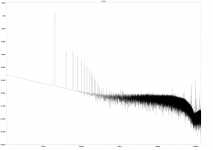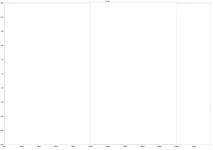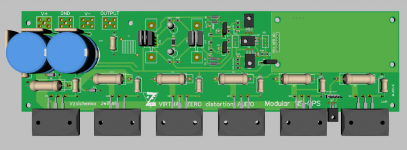That's what I suspected. Second channel isn't going as well. I mixed up the colour codes on my input power wires. I didn't notice this until some caps started bulging. At least I caught it before it stunk my office up!
I've go the front end voltage up higher now with parallel 5k6 resistors, but it's still not right. Positive rail is at 11.2 and negative at 14. I'm not able to get any bias current at all now. I was getting some before. This is the same on both channels.
I've go the front end voltage up higher now with parallel 5k6 resistors, but it's still not right. Positive rail is at 11.2 and negative at 14. I'm not able to get any bias current at all now. I was getting some before. This is the same on both channels.
Need to get solid 15V there. I will look at it closer in the morning. 2 am here now 🙂
A variation...
Hello all,
Have been following Valery's current driven VAS idea. Find it very interesting and full of potential.
This variation is based on Edmond Stuarts's SuperTis front end but simplified. Gone are the cascodes and baxandall super pairs. Super TIS
This front end gives a form of CMCL. Necessary when using a symmetrical front end with current mirrors. This then feeds the current driven VAS directly without any level shifting. The current is "added together" rather than subtracted. Subtracting current on both halves of the amplifier is the same as adding the currents.
This amplifier has a fast slewrate (approx. 300V/uS), good stability margins / profile (PM = 94 degrees, GM = 25dB @ ULGF 2.7Mhz) and a nice harmonic profile. This design, however, is not chasing single ppm THD.
Enjoy 🙂 ...hopefully...
Paul
Hello all,
Have been following Valery's current driven VAS idea. Find it very interesting and full of potential.
This variation is based on Edmond Stuarts's SuperTis front end but simplified. Gone are the cascodes and baxandall super pairs. Super TIS
This front end gives a form of CMCL. Necessary when using a symmetrical front end with current mirrors. This then feeds the current driven VAS directly without any level shifting. The current is "added together" rather than subtracted. Subtracting current on both halves of the amplifier is the same as adding the currents.
This amplifier has a fast slewrate (approx. 300V/uS), good stability margins / profile (PM = 94 degrees, GM = 25dB @ ULGF 2.7Mhz) and a nice harmonic profile. This design, however, is not chasing single ppm THD.
Enjoy 🙂 ...hopefully...
Paul
Attachments
Hello all,
Have been following Valery's current driven VAS idea. Find it very interesting and full of potential.
This variation is based on Edmond Stuarts's SuperTis front end but simplified. Gone are the cascodes and baxandall super pairs. Super TIS
This front end gives a form of CMCL. Necessary when using a symmetrical front end with current mirrors. This then feeds the current driven VAS directly without any level shifting. The current is "added together" rather than subtracted. Subtracting current on both halves of the amplifier is the same as adding the currents.
This amplifier has a fast slewrate (approx. 300V/uS), good stability margins / profile (PM = 94 degrees, GM = 25dB @ ULGF 2.7Mhz) and a nice harmonic profile. This design, however, is not chasing single ppm THD.
Enjoy 🙂 ...hopefully...
Paul
😎

Paul, looks cool 😎
It's fast and clean in terms of the loop phase response - that's what I especially like. Simple, light compensation - lead+shunt.
The only thing I'd probably like to re-arrange, is to allow the input stage using the lower rails (e.g. +/-15V).
It's fast and clean in terms of the loop phase response - that's what I especially like. Simple, light compensation - lead+shunt.
The only thing I'd probably like to re-arrange, is to allow the input stage using the lower rails (e.g. +/-15V).
Paul, looks cool 😎
It's fast and clean in terms of the loop phase response - that's what I especially like. Simple, light compensation - lead+shunt.
The only thing I'd probably like to re-arrange, is to allow the input stage using the lower rails (e.g. +/-15V).
Hi Valery,
Thank you for the feedback.
Agree with you with trying to redesign for lower voltage rails. Have been considering an output stage with gain.
The reason for going with the higher front end rails was to lose the common base cascode that sat between the LTP and VAS current sources. Saw this as an additional pole for no real gain since current gain of the cascode was 1. All this did was level shift.
Maybe there is a more elegant way to reduce the front end rail voltage?
Paul
Hello all,
Have been following Valery's current driven VAS idea. Find it very interesting and full of potential.
This variation is based on Edmond Stuarts's SuperTis front end but simplified. Gone are the cascodes and baxandall super pairs. Super TIS
This front end gives a form of CMCL. Necessary when using a symmetrical front end with current mirrors. This then feeds the current driven VAS directly without any level shifting. The current is "added together" rather than subtracted. Subtracting current on both halves of the amplifier is the same as adding the currents.
This amplifier has a fast slewrate (approx. 300V/uS), good stability margins / profile (PM = 94 degrees, GM = 25dB @ ULGF 2.7Mhz) and a nice harmonic profile. This design, however, is not chasing single ppm THD.
Enjoy 🙂 ...hopefully...
Paul
Attachments
OK, I have returned to 4-points drive of the VAS output CCSs.
Excellent simulated performance - distortion, speed, phase response, transients handling, very clean clipping. Loop gain/phase curves are incredibly clean, the front-end is not "nervous" at all 😎
OLG is 70db throughout the audio bandwidth, CLG = 29db, LG = 41db.
Still not sure if I want to split R21 in 2 halves and ground the middle point or leave it floating. We'll see at the prototype 😉
Great concept
Great concept
Thank you Veysel! 😉
1) v -> i
2) i -> I
3) I -> V
Constant voltage / constant power wherever possible 😎
I'm getting down to soldering the last few bits on the vertical cfa with NS OPS. Well laid out boards. There are a lot of parts on these boards... it took me quite a while to get all the passives soldered.
All of the active parts match up well except Q1/Q2. Should I be concerned if I can't get a good hFE match on Q1/Q2? Q1 bc556 has quite a bit higher hFE then it's Q2 bc546 compliment. They are the same rank parts. I checked bc560/550 compliments I have in stock...same deal. I would guess the servo will take care of the mismatch but it seems to my novice mind that starting where you want to finish is better then correcting on the way.
Thanks for the help,
Evan
All of the active parts match up well except Q1/Q2. Should I be concerned if I can't get a good hFE match on Q1/Q2? Q1 bc556 has quite a bit higher hFE then it's Q2 bc546 compliment. They are the same rank parts. I checked bc560/550 compliments I have in stock...same deal. I would guess the servo will take care of the mismatch but it seems to my novice mind that starting where you want to finish is better then correcting on the way.
Thanks for the help,
Evan
Attachments
I wouldn't worry about it too much. It's almost impossible to get a match in complimentary pairs.
Thanks Jeff. Boards will be done tonight. Probably a couple weeks before I can get heatsinks and try them out.
Evan
Evan
Hi Evan,
I'm trying to remember if I've sent you the latest recommendation on the caps values (I hope I did):
C18, C19 = 100pF;
C30, C31 = 47pF.
Looking forward to seeing your build 😎
Cheers,
Valery
I'm trying to remember if I've sent you the latest recommendation on the caps values (I hope I did):
C18, C19 = 100pF;
C30, C31 = 47pF.
Looking forward to seeing your build 😎
Cheers,
Valery
Valery,
Jeff sent a great BOM and let me know about the two cap changes. The layout is nice...tidy but not crowded. Once this amp is finished I can try going fully active. Right now I use a passive crossover from the midrange to the tweeter. Once the setup is active I can delay the mids and highs a bit. We will see.
Thanks,
Evan
Jeff sent a great BOM and let me know about the two cap changes. The layout is nice...tidy but not crowded. Once this amp is finished I can try going fully active. Right now I use a passive crossover from the midrange to the tweeter. Once the setup is active I can delay the mids and highs a bit. We will see.
Thanks,
Evan
Valery,
Jeff sent a great BOM and let me know about the two cap changes. The layout is nice...tidy but not crowded. Once this amp is finished I can try going fully active. Right now I use a passive crossover from the midrange to the tweeter. Once the setup is active I can delay the mids and highs a bit. We will see.
Thanks,
Evan
Sounds great. Jeff did this layout - I also like it a lot.
- Home
- Amplifiers
- Solid State
- Revisiting some "old" ideas from 1970's - IPS, OPS




